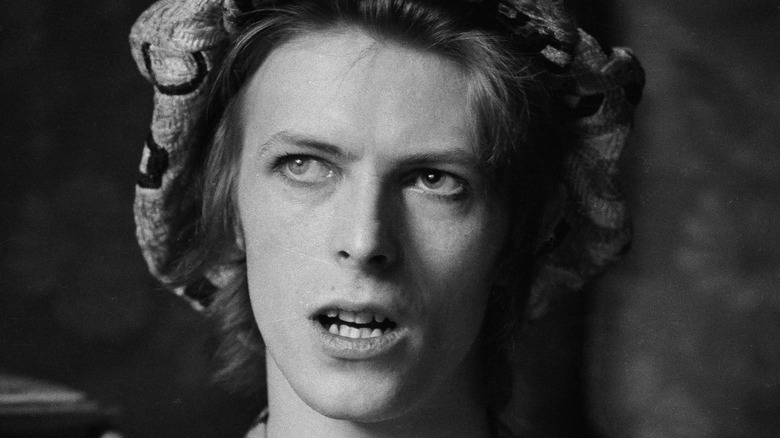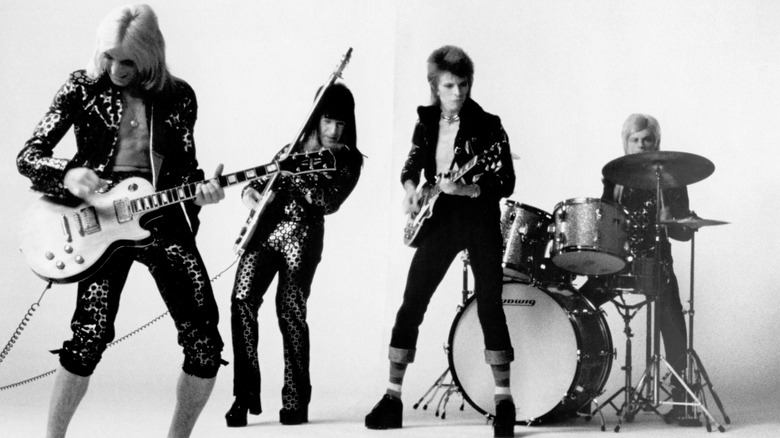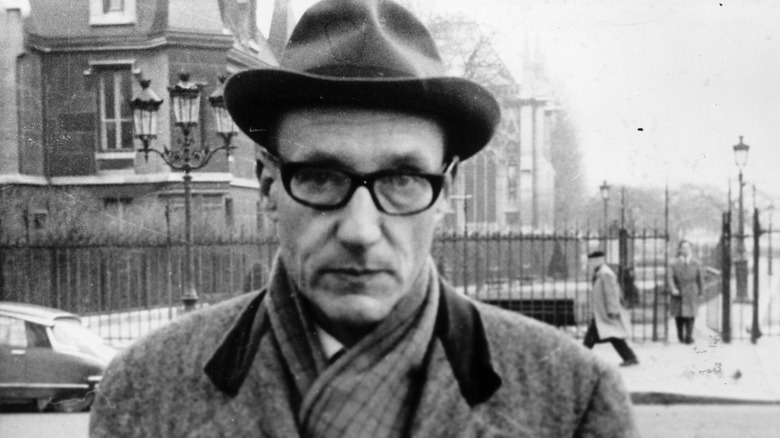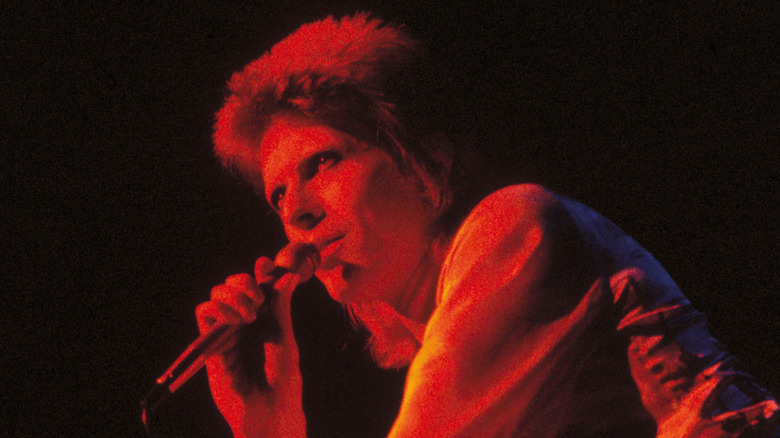The Real Story Behind David Bowie's Moonage Daydream
Arguably one of David Bowie's most beloved songs is "Moonage Daydream," a scorching standout track from his seminal 1972 opus "The Rise and Fall of Ziggy Stardust and the Spiders from Mars." When this album was published in 1972, it was a big hit on both sides of the Atlantic and drew attention to the mysterious and mystical David Bowie, who was yearning for a breakthrough at the moment. Critics and fans alike have been scratching their heads for decades, trying to figure out what "Moonage Daydream" is all about.
Is it the story of a bisexual alien superstar who comes to Earth to save humanity from annihilation? Is it really an "erotic fantasy" about space age achievements and moon-worshiping cults? — as some commentators believe (per The Times). Or could it instead be a journey into David Bowie's subconscious? To understand what the song signifies, one must first look at how the unconventional way it was composed. To get to the heart of what the intention of "Moonage Daydream" really is, we'll draw a link between the history of this music and the unique composition approaches used in its creation, as well as show how it owes a lot to one of the Dada movement's most controversial figures, the Beat Generations' very own William S. Burroughs.
Back to the Drawing Board
The origins of "Moonage Daydream" as a piece of music are intriguing. What makes it so fascinating is that epitomizes Bowie's talents as a musical chameleon as well as his phoenix-like ability to re-emerge from the ashes of his own work and perpetually reinvent himself. According to Mick Ronson, the lead guitarist on the track, ”Moonage Daydream” was originally written to launch the musical career of Freddie Buretti. Buretti was a London costume designer whom David Bowie met in a gay bar in London in 1971 and became infatuated with (via ”Beside Bowie: Mick Ronson Story).
"Moonage Daydream," was originally released in 1971 to lackluster acclaim as part of Bowie's short-lived side project with Buretti, The Arnold Corns. Unsatisfied with the mediocre reception, Bowie felt the song needed to be reshaped and headed back to the drawing board. Wading into the bizarre, organizing and rearranging it, and trusting in the visual imagination — all in search of the muse — is intrinsic to Bowie's craft.
As he told The New York Times, in a 1998 interview: ”I'd find that if I had some creative obstacle in the music that I was working on, I would often revert to drawing it out or painting it out. Somehow the act of trying to recreate the structure of the music in paint or in drawing would produce a breakthrough.”
As we'll see, Bowie used this technique in droves to elevate "Moonage Daydream" to its otherworldly ultimate form, all with the unintentional assistance of William S. Burroughs.
Dadaism and The Cut-Up Technique
The Cut-Up Technique was a postmodernist literary technique pioneered by important figures in the Dada movement, a significant 20th-century art movement that turned to the surreal to find meaning in a Europe devastated by the trauma of two World Wars. Although Burroughs did not invent this method (it is credited to the 1920s artist Tristan Tzara), he used it in his novels and popularized it in the '50s and beyond the Beat Movement, per Open Culture. This writing approach reorganizes existing words from random pages in unexpected ways to produce new meanings with their new jumbled structures.
Bowie embraced this process wholeheartedly and used it to write lyrics for several of his songs, including a reworked version of "Moonage Daydream" (as this YouTube clip shows). The lyrics; "I'm an alligator / I'm a Mama-Papa coming for you," or "Keep your electric eye on me, love / Put your ray gun to my skull," should make more sense now.
Throughout his illustrious career, Bowie used this strategy frequently to reinvent himself and his music (via BBC News). He acknowledged Burroughs' influence and called the cut-up montage approach "very Western tarot." Bowie would go on to remark, "What I've used it for, more than anything else, is lighting anything that could be in my mind," and claim, "I was discovering great things about myself, what I'd done, and where I was heading" (via Youtube).
Freak Out on a Moonage Daydream
This kaleidoscopic approach of isolating and re-contextualizing old ideas would also be used in the production of "Moonage Daydream." According to Nicholas Pegg's "The Complete David Bowie," Bowie later admitted to stealing an idea from The Hollywood Argyles' "Sure Know a Lot About Love," which has the unusual combination of baritone sax and a piccolo, for the bridge of his own tune. This would not, however, be Bowie's sole 20th-century avant-garde technique on the tune.
During the recording of "Moonage Daydream," Bowie collaborated closely with his then-partner-in-crime Mick Ronson and Ken Scott, who was crucial in shaping the album's distinctive glam rock sound. Ronson, who played lead guitar and composed many of the album's extravagant string arrangements, was an unofficial producer of sorts (via ”Beside Bowie: Mick Ronson Story).
Before recording his guitar solo for the outro, Bowie provided Ronson with a crude kind of graphic score that was directly inspired by Frank Zappa. Instead of sheet music, Bowie gave Ronson a rough felt-tip drawing of a "huge megaphone type shape" with "sprays of broken lines" and instructed him to and conjure up a solo from what he saw (per "The Complete David Bowie”). To Bowie's astonishment, Ronson was to interpret this exactly and nail the solo, which has since become iconic (per The Guardian).
Given the variety of influences and techniques that were taken, chopped up, and recreated to create the mind-blowing final composition, it's easy to see why "Moonage Daydream" remains one of Bowie's most enduring and electrifying tunes.



